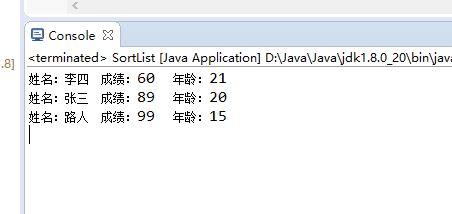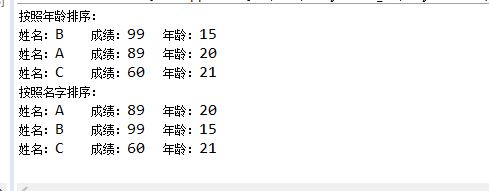1. 通过实现Comparable接口,来对集合中的自定义对象排序
代码:
import java.util.*;
class Student implements Comparable<Student>{
private String name;
private int score;
private int age;
public Student() {}
public Student(String name, int score,int age) {
this.name = name;
this.score = score;
this.age = age;
}
public String getName() {
return this.name;
}
public int getScore() {
return this.score;
}
public int getAge(){
return this.age;
}
public void setName(String name) {
this.name = name;
}
public void setScore(int score) {
this.score = score;
}
public void setAge(int age){
this.age = age;
}
public String toString(){
return "姓名:"+this.getName()+"\t成绩:"+this.getScore()+"\t年龄:"+this.getAge();
}
@Override
public int compareTo(Student stu) {
return this.getScore()-stu.getScore();
}
}
public class SortList {
public static void main(String [] args){
List<Student> list = new ArrayList<Student>();
list.add(new Student("张三",89,20));
list.add(new Student("李四",60,21));
list.add(new Student("路人",99,15));
Collections.sort(list);
for(Student stu : list){
System.out.println(stu.toString());
}
}
}
- 1
- 2
- 3
- 4
- 5
- 6
- 7
- 8
- 9
- 10
- 11
- 12
- 13
- 14
- 15
- 16
- 17
- 18
- 19
- 20
- 21
- 22
- 23
- 24
- 25
- 26
- 27
- 28
- 29
- 30
- 31
- 32
- 33
- 34
- 35
- 36
- 37
- 38
- 39
- 40
- 41
- 42
- 43
- 44
- 45
- 46
- 47
- 48
- 49
- 50
- 51
- 52
- 53
- 54
- 55
- 56
- 57
- 58
- 59
- 60
- 61
- 62
- 63
- 64
- 65
- 66
- 67
- 1
- 2
- 3
- 4
- 5
- 6
- 7
- 8
- 9
- 10
- 11
- 12
- 13
- 14
- 15
- 16
- 17
- 18
- 19
- 20
- 21
- 22
- 23
- 24
- 25
- 26
- 27
- 28
- 29
- 30
- 31
- 32
- 33
- 34
- 35
- 36
- 37
- 38
- 39
- 40
- 41
- 42
- 43
- 44
- 45
- 46
- 47
- 48
- 49
- 50
- 51
- 52
- 53
- 54
- 55
- 56
- 57
- 58
- 59
- 60
- 61
- 62
- 63
- 64
- 65
- 66
- 67
运行结果:
2.通过实现Comparator接口,来对集合中的自定义对象排序,该方式相对于上一种方式优势在于可以按多种规则排序
代码:
import java.util.*;
class Student {
private String name;
private int score;
private int age;
public Student() {}
public Student(String name, int score,int age) {
this.name = name;
this.score = score;
this.age = age;
}
public String getName() {
return this.name;
}
public int getScore() {
return this.score;
}
public int getAge(){
return this.age;
}
public void setName(String name) {
this.name = name;
}
public void setScore(int score) {
this.score = score;
}
public void setAge(int age){
this.age = age;
}
public String toString(){
return "姓名:"+this.getName()+"\t成绩:"+this.getScore()+"\t年龄:"+this.getAge();
}
}
class sortAge implements Comparator<Student>{
@Override
public int compare(Student stu1, Student stu2) {
return stu1.getAge()-stu2.getAge();
}
}
class sortName implements Comparator<Student>{
@Override
public int compare(Student stu1, Student stu2) {
return stu1.getName().compareTo(stu2.getName());
}
}
public class SortList {
public static void main(String [] args){
List<Student> list = new ArrayList<Student>();
list.add(new Student("A",89,20));
list.add(new Student("C",60,21));
list.add(new Student("B",99,15));
Collections.sort(list,new sortAge());
System.out.println("按照年龄排序:");
for(Student stu : list){
System.out.println(stu.toString());
}
Collections.sort(list,new sortName());
System.out.println("按照名字排序:");
for(Student stu : list){
System.out.println(stu.toString());
}
}
}
- 1
- 2
- 3
- 4
- 5
- 6
- 7
- 8
- 9
- 10
- 11
- 12
- 13
- 14
- 15
- 16
- 17
- 18
- 19
- 20
- 21
- 22
- 23
- 24
- 25
- 26
- 27
- 28
- 29
- 30
- 31
- 32
- 33
- 34
- 35
- 36
- 37
- 38
- 39
- 40
- 41
- 42
- 43
- 44
- 45
- 46
- 47
- 48
- 49
- 50
- 51
- 52
- 53
- 54
- 55
- 56
- 57
- 58
- 59
- 60
- 61
- 62
- 63
- 64
- 65
- 66
- 67
- 68
- 69
- 70
- 71
- 72
- 73
- 74
- 75
- 76
- 77
- 78
- 79
- 80
- 81
- 82
- 83
- 84
- 85
- 86
- 87
- 88
- 89
- 90
- 91
- 92
- 93
- 94
- 95
- 96
- 97
- 1
- 2
- 3
- 4
- 5
- 6
- 7
- 8
- 9
- 10
- 11
- 12
- 13
- 14
- 15
- 16
- 17
- 18
- 19
- 20
- 21
- 22
- 23
- 24
- 25
- 26
- 27
- 28
- 29
- 30
- 31
- 32
- 33
- 34
- 35
- 36
- 37
- 38
- 39
- 40
- 41
- 42
- 43
- 44
- 45
- 46
- 47
- 48
- 49
- 50
- 51
- 52
- 53
- 54
- 55
- 56
- 57
- 58
- 59
- 60
- 61
- 62
- 63
- 64
- 65
- 66
- 67
- 68
- 69
- 70
- 71
- 72
- 73
- 74
- 75
- 76
- 77
- 78
- 79
- 80
- 81
- 82
- 83
- 84
- 85
- 86
- 87
- 88
- 89
- 90
- 91
- 92
- 93
- 94
- 95
- 96
- 97
运行结果:
-----------------------------------------------另外的介绍-------------------------------------------
Java集合的工具类Collections中提供了两种排序的方法,分别是:
- Collections.sort(List list)
- Collections.sort(List list,Comparator c)
第一种称为自然排序,参与排序的对象需实现comparable接口,重写其compareTo()方法,方法体中实现对象的比较大小规则,示例如下:
实体类:(基本属性,getter/setter方法,有参无参构造方法,toString方法)
package test;
public class Emp implements Comparable {
private String name;
private int age;
public String getName() {
return name;
}
public void setName(String name) {
this.name = name;
}
public int getAge() {
return age;
}
public void setAge(int age) {
this.age = age;
}
public Emp() {
super();
}
public Emp(String name, int age) {
super();
this.name = name;
this.age = age;
}
@Override
public String toString() {
return "Emp [name=" + name + ", age=" + age + "]";
}
@Override
public int compareTo(Object o) {
if(o instanceof Emp){
Emp emp = (Emp) o;
return this.name.compareTo(emp.getName());
}
throw new ClassCastException("不能转换为Emp类型的对象...");
}
}
- 1
- 2
- 3
- 4
- 5
- 6
- 7
- 8
- 9
- 10
- 11
- 12
- 13
- 14
- 15
- 16
- 17
- 18
- 19
- 20
- 21
- 22
- 23
- 24
- 25
- 26
- 27
- 28
- 29
- 30
- 31
- 32
- 33
- 34
- 35
- 36
- 37
- 38
- 39
- 40
- 41
- 1
- 2
- 3
- 4
- 5
- 6
- 7
- 8
- 9
- 10
- 11
- 12
- 13
- 14
- 15
- 16
- 17
- 18
- 19
- 20
- 21
- 22
- 23
- 24
- 25
- 26
- 27
- 28
- 29
- 30
- 31
- 32
- 33
- 34
- 35
- 36
- 37
- 38
- 39
- 40
- 41
第二种叫定制排序,或自定义排序,需编写匿名内部类,先new一个Comparator接口的比较器对象c,同时实现compare()其方法;
然后将比较器对象c传给Collections.sort()方法的参数列表中,实现排序功能;
说明:第一种方法不够灵活,实体类实现了comparable接口后,会增加耦合,如果在项目中不同的位置需要根据不同的属性调用排序方法时,需要反复修改比较规则(按name还是按age),二者只能选择其一,会起冲突.第二种就很好地解决了这个问题.在需要的地方,创建个内部类的实例,重写其比较方法即可.
jUnit4单元测试类代码如下:
package test;
import java.util.ArrayList;
import java.util.Collections;
import java.util.Comparator;
import java.util.List;
import org.junit.BeforeClass;
import org.junit.Test;
public class TestSort {
static List list = new ArrayList();
@BeforeClass
public static void init(){
list.add(new Emp("tom",18));
list.add(new Emp("jack",20));
list.add(new Emp("rose",15));
list.add(new Emp("jerry",17));
System.out.println("排序前:");
for(Object o : list){
System.out.println(o);
}
}
/**按age升序排序*/
/**按name升序排序*/
@Test
public void testSortName(){
Collections.sort(list);
System.out.println("自然排序按name升序排序后:");
for(Object o : list){
System.out.println(o);
}
}
/**使用Comparator比较器按age升序排序*/
@Test
public void testComparatorSortAge(){
Collections.sort(list,new Comparator () {
@Override
public int compare(Object o1, Object o2) {
if(o1 instanceof Emp && o2 instanceof Emp){
Emp e1 = (Emp) o1;
Emp e2 = (Emp) o2;
return e1.getAge() - e2.getAge();
}
throw new ClassCastException("不能转换为Emp类型");
}
});
System.out.println("使用Comparator比较器按age升序排序后:");
for(Object o : list){
System.out.println(o);
}
}
/**使用Comparator比较器按name升序排序*/
@Test
public void testComparatorSortName(){
Collections.sort(list,new Comparator () {
@Override
public int compare(Object o1, Object o2) {
if(o1 instanceof Emp && o2 instanceof Emp){
Emp e1 = (Emp) o1;
Emp e2 = (Emp) o2;
return e1.getName().compareTo(e2.getName());
}
throw new ClassCastException("不能转换为Emp类型");
}
});
System.out.println("使用Comparator比较器按name升序排序后:");
for(Object o : list){
System.out.println(o);
}
}
}
- 1
- 2
- 3
- 4
- 5
- 6
- 7
- 8
- 9
- 10
- 11
- 12
- 13
- 14
- 15
- 16
- 17
- 18
- 19
- 20
- 21
- 22
- 23
- 24
- 25
- 26
- 27
- 28
- 29
- 30
- 31
- 32
- 33
- 34
- 35
- 36
- 37
- 38
- 39
- 40
- 41
- 42
- 43
- 44
- 45
- 46
- 47
- 48
- 49
- 50
- 51
- 52
- 53
- 54
- 55
- 56
- 57
- 58
- 59
- 60
- 61
- 62
- 63
- 64
- 65
- 66
- 67
- 68
- 69
- 70
- 71
- 72
- 73
- 74
- 75
- 76
- 77
- 78
- 79
- 80
- 81
- 82
- 83
- 84
- 85
- 86
- 87
- 88
- 1
- 2
- 3
- 4
- 5
- 6
- 7
- 8
- 9
- 10
- 11
- 12
- 13
- 14
- 15
- 16
- 17
- 18
- 19
- 20
- 21
- 22
- 23
- 24
- 25
- 26
- 27
- 28
- 29
- 30
- 31
- 32
- 33
- 34
- 35
- 36
- 37
- 38
- 39
- 40
- 41
- 42
- 43
- 44
- 45
- 46
- 47
- 48
- 49
- 50
- 51
- 52
- 53
- 54
- 55
- 56
- 57
- 58
- 59
- 60
- 61
- 62
- 63
- 64
- 65
- 66
- 67
- 68
- 69
- 70
- 71
- 72
- 73
- 74
- 75
- 76
- 77
- 78
- 79
- 80
- 81
- 82
- 83
- 84
- 85
- 86
- 87
- 88
右键空白位置 —> Run As —> JUnit Test —>
运行结果如下:
排序前:
Emp [name=tom, age=18]
Emp [name=jack, age=20]
Emp [name=rose, age=15]
Emp [name=jerry, age=17]
自然排序按name升序排序后:
Emp [name=jack, age=20]
Emp [name=jerry, age=17]
Emp [name=rose, age=15]
Emp [name=tom, age=18]
使用Comparator比较器按age升序排序后:
Emp [name=rose, age=15]
Emp [name=jerry, age=17]
Emp [name=tom, age=18]
Emp [name=jack, age=20]
使用Comparator比较器按name升序排序后:
Emp [name=jack, age=20]
Emp [name=jerry, age=17]
Emp [name=rose, age=15]
Emp [name=tom, age=18]























 2684
2684

 被折叠的 条评论
为什么被折叠?
被折叠的 条评论
为什么被折叠?








